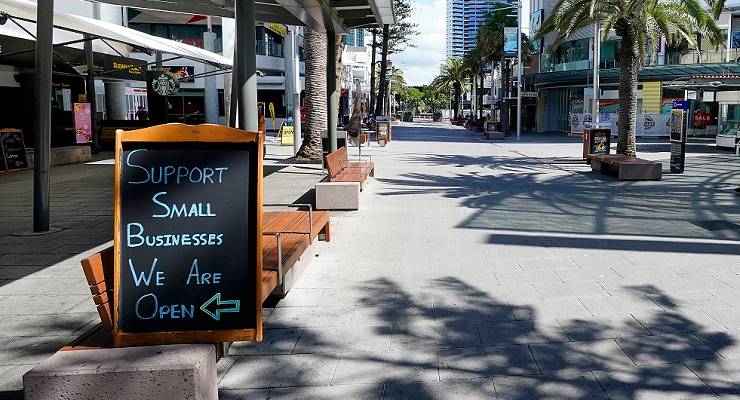
Shuttered small businesses should use this enforced downtime to take a good hard look at themselves.
In many cases the current coronavirus crisis is only exacerbating, not causing, their future collapse. Just ask any overworked accountant at the moment.
Now I know it’s almost un-Australian to criticise the “engine room of the economy”; the 2.2 million small enterprises which employ almost half our workforce.
While government, banks and employees are all keen to do everything to ensure all businesses can snap back, not all can or should.
The hospitality sector, for example, had continuously argued that they were on such low margins that they could not even afford to pay their workers the correct wages.
“Too high, too complex,” they argued. Well now they have plenty of time to catch up on the correct awards and check the books to see what they should be paying and, more crucially, if they can afford to pay it.
Some greedy landlords might be on the back foot for the moment, but they will eventually return to their bad old ways of hiking rents and letting tenants close.
In the new economic order maybe we have to question whether we really need so many cafes, restaurants, hairdressers, massage therapists, nail salons and the like.
And we definitely have to wonder just how many eyebrow shaping salons our population can sustain.
The move to these service industries came at the expense of brick and mortar shops. Small and large, they were already suffering a retail apocalypse before the current health crisis or the earlier bushfire crisis.
After this enforced isolation that downturn will only escalate.
Pity the poor frock shops. What on earth will happen to an entire season’s worth of fashion that was not worn and will be dated by the time they reopen?
When I started The Small Business Show on the Nine Network 25 years ago, the huge number of struggling hairdressers was a regular feature.
Their inability to attract workers has only worsened and the same problem persists. Just because you are handy with a pair of scissors does not mean you can open and run your own establishment successfully.
Ditto chefs.
God forbid we should admit that not everyone is cut out to run their own business; that the dream of being our own boss can in fact be a nightmare.
Traditionally some 60% of all small businesses are estimated to fail within the first three years and we don’t want that number escalating.
When a local cafe near me announced its accountant had advised it to close at the outset of the crisis, I encouraged neighbours to shops at stores they wanted to see survive at the end of this.
But despite all the current goodwill it is not clear just how much consumers are willing to pay to support their local businesses.
The Made In Australia campaign was a prime example of shoppers claiming they would prefer to buy home grown produce while in reality opting for the cheapest option even if it was sourced offshore.
Nowhere will this be crystalised more than in one of the hardest hit and over serviced sectors: restaurants.
This week Restaurant and Catering Australia CEO Wes Lambert said he held fears for 25% of the 47,000 odd restaurants nationwide, leading to the headline in the Good Food section that “12,000 restaurants may shut for good”.
Fewer restaurants means less competition and higher prices, a similar argument to the one playing out in the airline sector.
Just like the small businesses themselves, we’ll all have to do the sums and work out just who we can afford to save in the new economy.
Inevitably new business will be created to replace those that are lost and the jobs that go with them. Hopefully not all will be in the low paying gig economy.








This kind of small-scale retail and personal services trade is really a part of the distribution function in the economy, i.e., a means of distributing the social surplus among a sufficiently wide portion of the population. If we were to reduce this sector as part of a “rationalisation” of the economy, then serious attention would have to be paid to replacing the distributive role it plays. Welfare payments maybe?
While telling us that life is going to be different, this projection assumes that some things won’t change.
“Some greedy landlords … will eventually return to their bad old ways of hiking rents and letting tenants close.” That worked when there was always another aspiring cafe or eyebrow-shaper or clothing chain ready to move in.
“ Fewer restaurants means less competition and higher prices, a similar argument to the one playing out in the airline sector.” Maybe when we finally get to play outside $100 dinners will no longer seem the norm. Maybe the workers returning to offices will realise they don’t need a $15 sandwich and a couple of $5 coffees to get through the day while wondering why they can’t save. Losing 25% of 47,000 restaurants is hardly comparable to having one domestic airline instead of one.
Oops, obviously that should be one airline instead of two.
Do we need so many cafes? You really need to get out more JP, like to Europe! Forget the US or Oz, there is nothing more satisfying or congenial than, European style, having a pub or restaurant/cafe ‘on every corner’. Having spent many years overseas that’s the one thing I miss most. Besides, it’s a great way of spreading wealth locally.
The difference in Europe is population density. They don’t have 2/3rds of their population in sprawling suburbs, spending 2-3 hours a day commuting. Plus their cost of living is lower so they can afford to eat out a bit more often, and pay a bit more for it.
I agree, PH, but the vast majority of our towns are just badly designed, it’s almost as if Australian planners have had some sort of sociability bypass. They don’t design for denser (and lower cost) housing in town centres, with the result that many towns are almost totally devoid of people after 7pm. As they say, it ain’t brain surgery.
One of BK’s frequent tropes is his belief that industry is old thinking and that the service economy is the future – so 80s Thatcherite.
Since globalisation began sucking the lifeblood out of national independence and pumping out cheap toys with a shorter useful life than fairfloss this country most of the West has relied on the old, wretched, tried & failed strategy of taking in each other’s laundry.
I didn’t even know that there was ever such a thing as eyebrow shaping salons but I’m certainly glad that the bush is back.
Much more comfortable for all concerned, though a bit scratchy in early recovery.
We don’t all want to look like John Howard you know!
I presume that you mean his rampant eyebrows rather than ‘down there’.
Ha ha I don’t even want to go “down” there!
Great article.
Back in the 80’s we paid 10 or 12 dollars for a pizza, and we thought that was normal. Two months ago, 34 years later, we would pay 6 dollars. Probably didn’t taste too much worse, and we bought it. Why was it so cheap?
Since then imported car prices halved (relatively) and house prices quadrupled (relatively…but you can’t live in a car).
Sitting at the canteen table (pre Corona), a couple of fathers, who have a comfortable life, would comment, “my daughters will never own a house, and they will probably still be at home when they are 30”. Why? Shouldn’t a “conservative” government want to go back to the $12 pizza and cheap house?
Pre Corona evenings, I would drive past those nail salons at 6 to 7 PM, and all the lights would be on, 10+ chairs with 1 or 2 customers. Could not figure how they could make a living with the cost of electricity as high as it is. Clearly shift allowance or penalty rates don’t figure.
It would be fantastic to get some balance back into society so it was livable. But that would take a dramatic change in government mentality of any colour.
Things aren’t priced properly. We don’t price waste and we don’t take into account the impact on the environment, and on our social fabric, when everything is so cheap